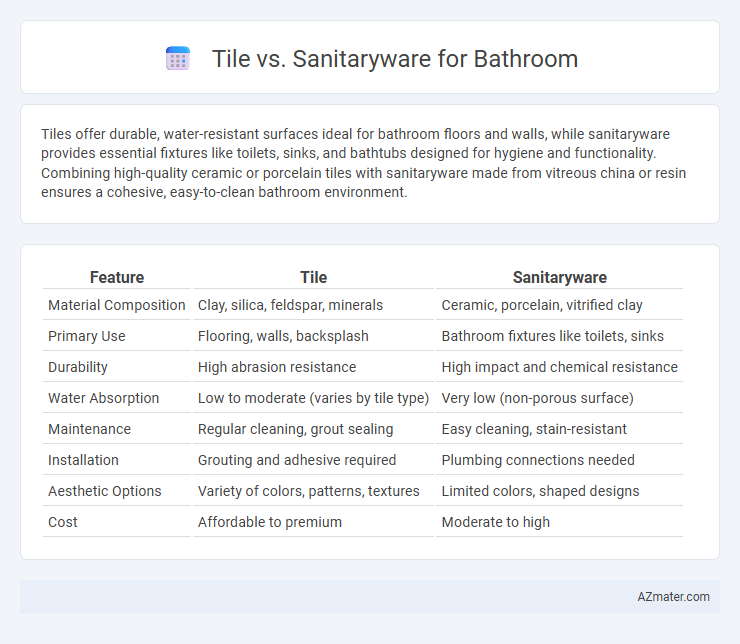Tiles offer durable, water-resistant surfaces ideal for bathroom floors and walls, while sanitaryware provides essential fixtures like toilets, sinks, and bathtubs designed for hygiene and functionality. Combining high-quality ceramic or porcelain tiles with sanitaryware made from vitreous china or resin ensures a cohesive, easy-to-clean bathroom environment.
Table of Comparison
| Feature | Tile | Sanitaryware |
|---|---|---|
| Material Composition | Clay, silica, feldspar, minerals | Ceramic, porcelain, vitrified clay |
| Primary Use | Flooring, walls, backsplash | Bathroom fixtures like toilets, sinks |
| Durability | High abrasion resistance | High impact and chemical resistance |
| Water Absorption | Low to moderate (varies by tile type) | Very low (non-porous surface) |
| Maintenance | Regular cleaning, grout sealing | Easy cleaning, stain-resistant |
| Installation | Grouting and adhesive required | Plumbing connections needed |
| Aesthetic Options | Variety of colors, patterns, textures | Limited colors, shaped designs |
| Cost | Affordable to premium | Moderate to high |
Introduction to Bathroom Surfacing: Tile vs Sanitaryware
Bathroom surfacing choices significantly influence durability, aesthetics, and maintenance, with tile and sanitaryware serving distinct yet complementary roles. Tiles, crafted from ceramic, porcelain, or natural stone, offer water resistance and design versatility for walls and floors. Sanitaryware includes fixtures like sinks, toilets, and bathtubs made from vitreous china or acrylic, essential for functionality and hygiene.
Material Composition: Tiles and Sanitaryware Explained
Tiles for bathrooms are primarily composed of ceramic, porcelain, or natural stone, offering durability, water resistance, and a variety of textures and finishes tailored for wet environments. Sanitaryware, including toilets, sinks, and bidets, is typically made from vitreous china or porcelain, materials known for their non-porous surfaces, ease of cleaning, and long-lasting hygiene properties. Understanding these material compositions helps in selecting the right products that combine aesthetics, functionality, and maintenance efficiency in bathroom design.
Design Versatility and Aesthetic Appeal
Tiles offer unparalleled design versatility with a wide range of colors, patterns, textures, and sizes that can create custom looks tailored to any bathroom style. Sanitaryware, including sinks, toilets, and bathtubs, contributes significantly to the bathroom's aesthetic appeal through sleek, modern designs and high-quality finishes that complement tile choices. Combining tiles with stylish sanitaryware enhances the overall visual harmony, allowing for personalized, sophisticated bathroom interiors.
Durability and Longevity Comparison
Tiles offer exceptional durability due to their resistance to scratches, moisture, and temperature changes, making them ideal for bathroom floors and walls. Sanitaryware, such as toilets and sinks made from ceramic or porcelain, provides long-lasting performance but may be prone to chipping if impacted. Both materials require proper maintenance to maximize longevity, with tiles generally offering a more resilient surface against daily wear and tear.
Maintenance and Cleaning Requirements
Tiles offer durability and resistance to stains, making them easy to clean with regular mopping or wiping using mild detergents, which helps prevent mold and mildew buildup in bathroom settings. Sanitaryware, such as toilets, sinks, and bidets, requires frequent cleaning with specialized bathroom cleaners to maintain hygiene and prevent limescale deposits and bacterial growth. Both materials benefit from routine maintenance, but tiles demand less intensive upkeep compared to sanitaryware due to their simpler surface and lower exposure to contaminants.
Installation Process and Costs
Tile installation in bathrooms involves surface preparation, waterproofing, and precise cutting, with costs ranging from $5 to $15 per square foot depending on material and complexity. Sanitaryware installation, such as toilets, sinks, and bathtubs, requires plumbing expertise and proper sealing, typically costing between $200 and $1,500 per fixture including labor. Overall, tile installation demands more extensive labor and time, while sanitaryware costs are higher per unit due to plumbing and fitting requirements.
Water Resistance and Slip Safety
Tiles offer superior water resistance due to their non-porous surface and high durability, making them ideal for wet bathroom areas. Sanitaryware, including toilets and sinks, is crafted from glazed ceramic materials that provide excellent water resistance but require slip-resistant treatments on floors for safety. Combining slip-resistant tiles with sanitaryware enhances bathroom safety by reducing fall risks and ensuring effective water management.
Environmental Impact and Sustainability
Tiles made from natural clay and recycled materials often have a lower carbon footprint compared to ceramic or porcelain sanitaryware, which require energy-intensive firing processes. Sanitaryware manufacturing generates significant water waste and emissions, while sustainable tile options can incorporate eco-friendly glazing and production techniques. Lifecycle assessments favor tiles with recycled content for reducing landfill waste and resource extraction, supporting greener bathroom renovations.
Price Comparison: Tiles vs Sanitaryware
Tiles for bathrooms typically cost between $1 to $15 per square foot, depending on material and design, making them a versatile choice for various budgets. Sanitaryware prices vary more broadly, with basic fixtures like toilets and sinks starting around $50 and premium brands exceeding $500 each, reflecting quality and brand differences. Budget planning should factor in both tile installation expenses and the cumulative cost of sanitaryware to achieve a balanced bathroom renovation.
Final Verdict: Choosing the Best Option for Your Bathroom
When selecting between tile and sanitaryware for your bathroom, prioritize tiles for surfaces like floors and walls due to their durability, moisture resistance, and design versatility. Sanitaryware, including toilets, sinks, and bathtubs, is essential for functionality and hygiene, often made from vitreous china or porcelain for easy maintenance. The best option combines high-quality tiles with reliable sanitaryware to create a bathroom that balances aesthetics, practicality, and long-term value.

Infographic: Tile vs Sanitaryware for Bathroom
 azmater.com
azmater.com